 |
|
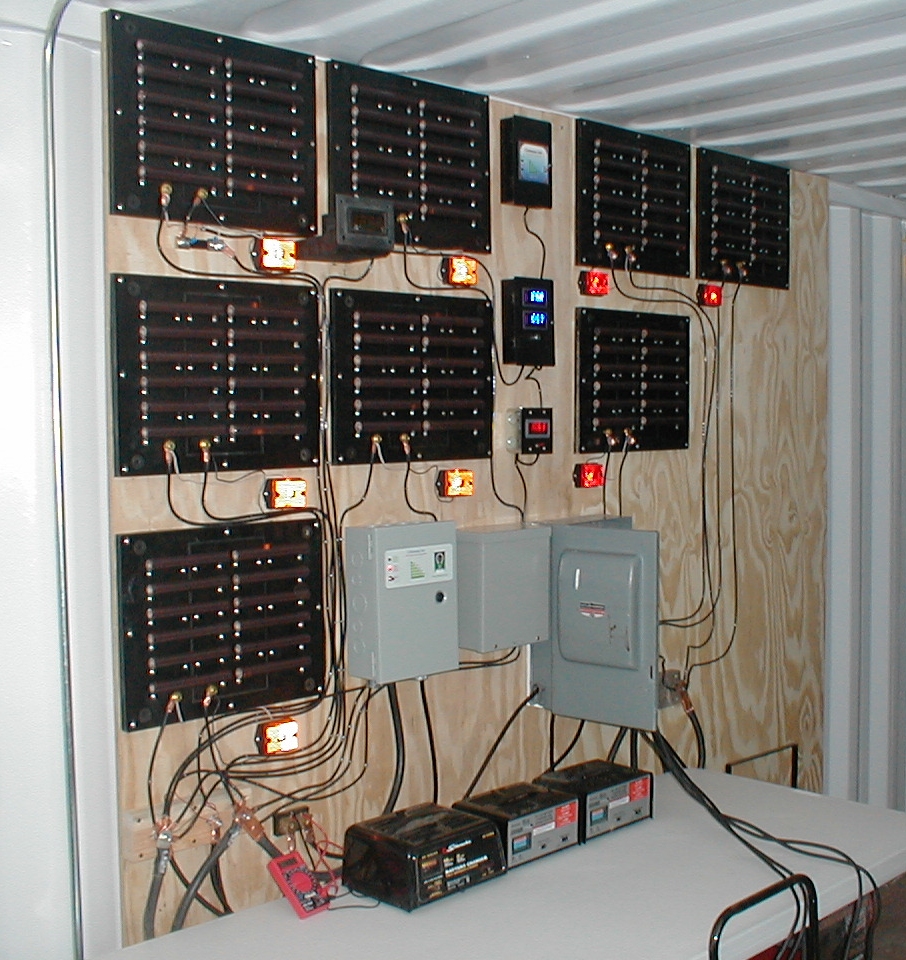
Pictured above is the torture bench that our Coleman Air C440 was forced to endure for two days and running. Each of the black panels on the wall are diversion load centers capable of disbursing 85 amps at 15 volts. There are 8 of these panels. 3 small battery charges are shown on the table in addtion (you cannot see well in this picture) are a 200 amp battery charger on the far right of the table, and (2) 200 amp chargers in the front of the table. Under the table are four 210 amp-hour deep cycle batteries and two super-start 1100 CCA batteries.
The lights on the wall are indicators that the panels are on and being driven by the C440.
This test was a great way to show off the Coleman Air C440, but there was more motivation. So why did we do this??
Back when we (Coleman Air) first designed the Coleman Air C440 (mid 2009), we purchased the relays from a source (who we will leave unnamed out of pure charity), a relay called the SEA-440 (or SEA440). The relay was the center of a charge controller being sold on ebay as a 10,000 watt, 440 amp controller. The controller itself was very limited in it's capability, but we were very impressed with the relay so we purchased the relay and designed our C440 around it.
Later, we located a distributor (for and approved by the original source) of this relay and they where able to provide us with the same relay at a better cost. We of course found that to be fine and continued to build and promote the C440 controller. Sometime later in our partnership with the new distributor, they (our new distributor), found that the SEA-440 relay was in-fact available from a different source and at yet a better price!
At this time we began to get a little suspicious. The SEA440 was supposedly custom made by the original source (including their 16 years of testing and R&D) and it (the SEA-440) was not available anywhere else. We confronted our distributor and they assured us that it was in-fact the exact same relay because they found the source's source!
So, having this conformation we rested, yet began to search out relay manufactures, to obtain a deeper understanding of the solenoid that we had within our C440.
In January of 2010, we became convinced that the relay being marketed as the SEA-440 was in-fact made in China and not only did it not have pure silver contacts, it had no silver in it at all. We have never made any claims as to the components in the relay, this was not the problem. The problem was we did rely on this information (from "the source") in marketing our C440 and of course we rely on relay itself to sustain 440 amps, and we have made that same claim for our C440s, and now; knowing that the relay was misrepresented to us --- well just what did we and our customers have OR not have?
The 1st thing we did was pull the C440 and C440-HVM off the market.
The next thing we did was tear apart the relays we had, and asked our distributor for any information they might have. They also tore into some relays they had from the original source as well as the newer relays they and been selling us.
The 1st thing we found out was that the original SEA-440 relay was a poorly made relay with poorly machined copper contacts and copper disc.
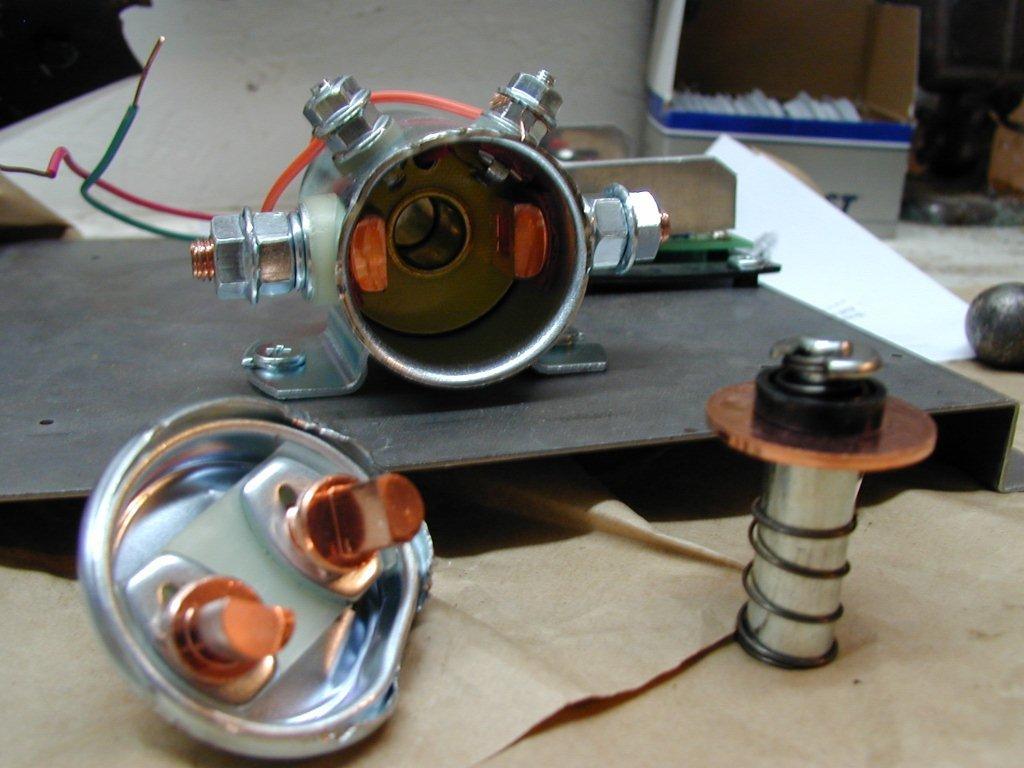
The Relay above is the original SEA-440 relay. This is the actual relay being sold by the "Original Source". As you can see the contacts and disc are copper, not "Heavy duty external LUGS complimented by .999 fine PURE Silver" as they claim in their auction and distribution sites.
Luckily, only the early C440's where actually built using this relay. The newer relay that our distributor was obtaining was infact a better relay with anti-arc coating on the disc. But how good, and could it truly handle 440 Amps?
We began to build a test environment where we could actually find out what this anti-arc relay was capable of running. At this same time we received the the 1st batch of new relays (that actually have silver contacts) from our new manufacturer who has custom made them to a much more demanding set of specifications. -- more on these relays later.
What was of paramount importance to us is --- could the current relay in our C440 actually handle 440 amps, and could it handle repeated breaks and makes at this extreme level and off course, how long could it tolerate this level.
So let the testing being. -- and the 1st thing (lots of firsts here) we found out is --- 440 amps is ALOT of current!!
.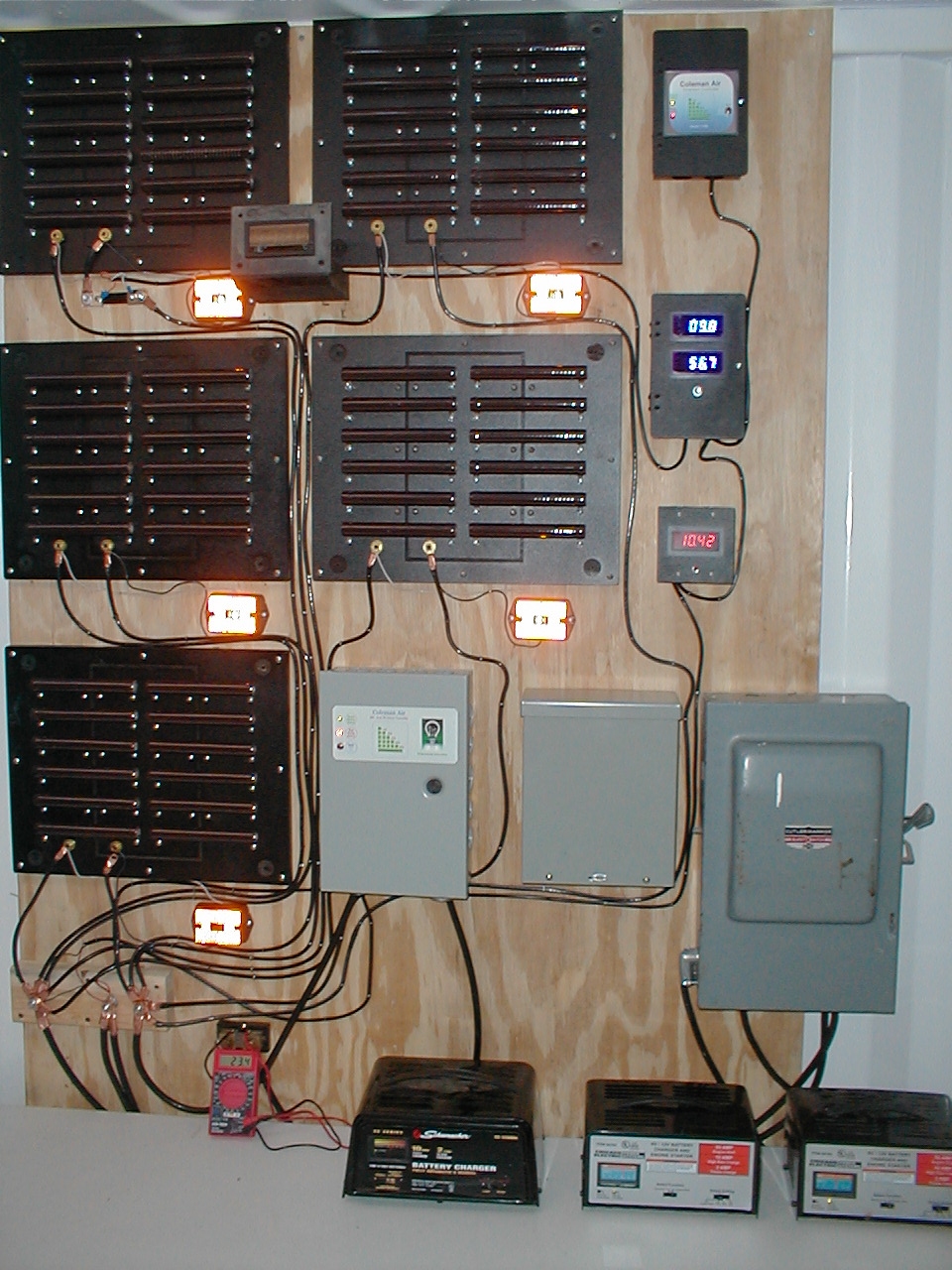
1st test attempt. See list of equipment below. The two blue meters are showing the voltage and amperage though the 1st panel (9.8 volts and 56.7 amps -- The batteries are at 15 volts when they trip! -- This is just pure copper loss) The red meter just below that reading 10.42 is the battery voltage as read at the terminal block on the far left. The hand held meter sitting on the table is showing the total amperage flowing through the C440 (234 amps).
| Quantity | Description |
| 5 | 85 amp diversion load centers. (12, 2 ohm resistors in parallel on each panel). |
| 4 | 6 volt, 210 Amp/Hour Deep cycle (Golf cart) batteries wired for 12 volt use. (Series/Parallel) |
| 3 | 15 amp battery charges. |
| 1 | 200 amp battery charger. |
| 1 | Coleman Air C440 and various meters and shunts. |
Well we simply could not generate 440 amps, we where dimming the lights each time the relay clicked in, but we could only get to about 234 amps! Even with what calculated out to be 425 amps load at 15 volts. The voltage was dropping to 10+ volts as soon as the C440 engaged. (When measured at the batteries, the voltage was still above 13.5 volts) So we purchased more batteries and two more 200 amp battery chargers. We almost got there, we could run about 325 amps.
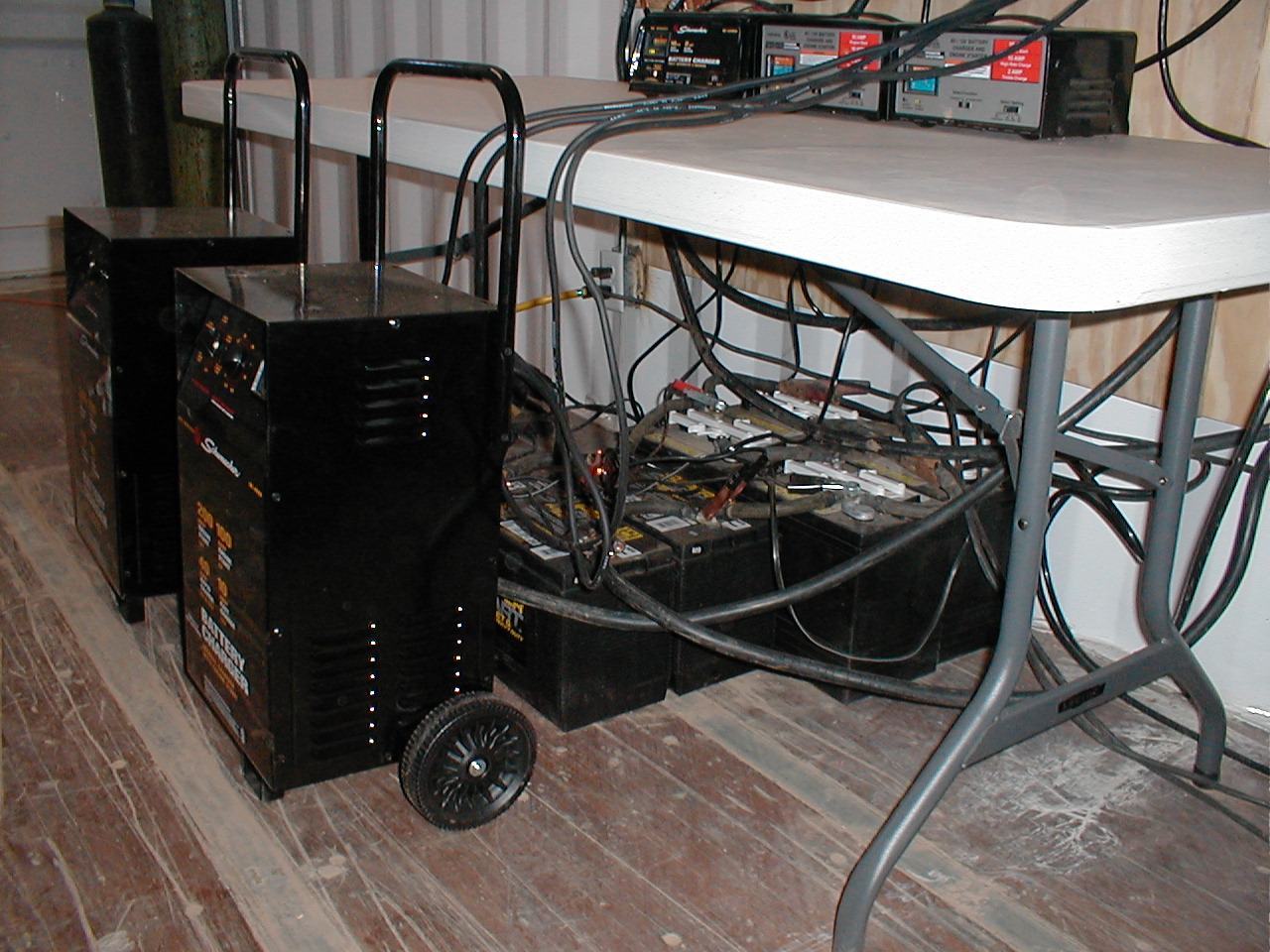
A mess of wiring, it started out a lot neater! There is one more charger to the right of this picture not visible in the photo. We have 4/0 cable running from both sides of the parallel battery banks up to the disconnect switch!
The problem was copper. We simply could not shove that much amperage though the #1 cable we 1st used.
T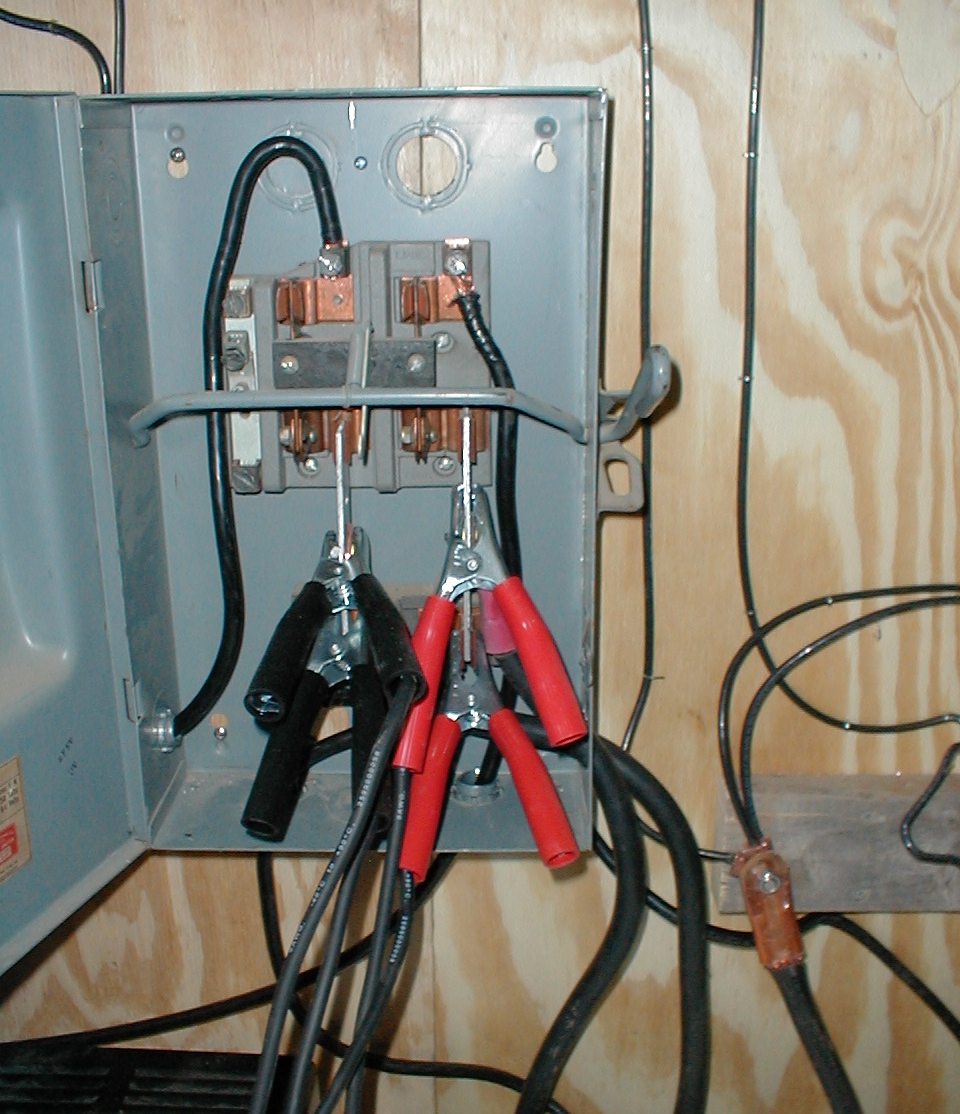
We connected the two new battery charges directly to the disconnect switch (wired it as a bottom feed and removed the fuses). We removed the clips from the the other 200 amp charger and terminated them directly to the batteries.
We where getting close, but still could not crack 400 amps. So we replaced more of the #1 cable with 4/0 cable, and hooked up another three 85 amp diversion loads. (8 total now. -- You can see the final setup in the top most picture)
.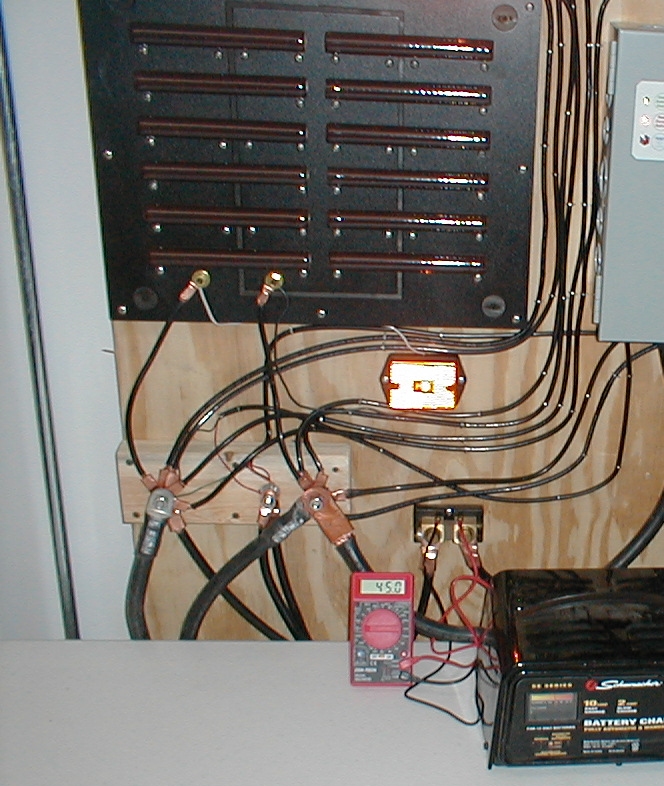
We finally got above 440 amps!!
With some more copper replacement, shorter wires and tighter connections we where able to maintain 467 amps!
The final equipment list is shown below:
| Quantify | Description |
| 8 | 85 amp diversion load centers. (12, 2 ohm resistors in parallel on each panel). |
| 4 | 6 volt, 210 Amp/Hour Deep cycle (Golf cart) batteries wired for 12 volt use. (Series/Parallel) |
| 2 | 12 volt heavy equipment starter batteries. 1100 CCA amps. |
| 3 | 15 amp battery charges. |
| 3 | 200 amp battery chargers. |
| 1 | Coleman Air C440 and various meters and shunts. |
| 1 | Amazed group of electricians at what it takes to generate 440 amps at 15 volts. |
Details of the test.
-
Total charge amperage available during off cycle of relay: 645 amps (Actual amperage flowing into the batteries is less than this)
-
Total available amperage at relay enable: 645 amps, plus the parallel battery banks of more than 2000 surge amps.
-
Total load (96, 2 ohm - 100 watt resistors -- or .0208 ohms at 15.25 volts = 733 amp load).
-
Measured amperage at relay enable (contact closure) - 467 amps.
-
Measured voltage at the batteries at time of relay enable (contact closure) - 15.25 volts.
-
Measured voltage at the C440 at time of relay enable (contact closure) - 10.5 volts.
-
Voltage drop in the copper from from batteries to the C440 at post enable: 4.75V
-
Wattage dissipated: 7121 watts (descending delta time)
-
Trip cycle frequency: About 25 seconds. (Every 19 seconds the relay is being engaged for 6 seconds then disengaged.)
-
Current length of test - 2 days (for all amperages) -- This test is still in progress!
Conclusions:
1st and foremost, the relay in the Coleman Air C440, does in-fact sustain 440 amps carry, and it is able to withstand repeated cycling at this level.
Secondly, 440 Amps is a lot of current and very difficult to achieve for a 12 volt system due to huge losses in the copper. It took several days and a nearly absurd assortment of battery chargers and copper to achieve this. It is extremely unlikely that any real world alternate energy system will ever produce 440 amps with a 12 volt system. The copper alone would cost more than the turbine!
Lastly, at 24 volts, 440 amps could be achieved much easier, but the relay is rated a no more than 10,000 watts so at a 30 volt trip this would translate to 333 amps. -- We will be testing for this in the next couple of days, but all expectations are that the relay will handle the 333 amps at 30 volts (trip point) just fine.
So the good news is that even though the relay is not the relay we thought we where getting, it does in fact hold up to the 440 amp claim. We are very pleased to say this, BUT we are not pleased with the misrepresentations that we had been given.
For all of you that have purchased our C440 in the past, rest assured the relay that you currently have will handle more than you are ever going to be able to throw at it! We tried to break this relay and could not. Most likely, the real world alternate energy system will be below 200 amps. We found it extremely difficult to achieve 440 amps! At the time of this writing (1/21/2010) we are at 467 amps in the test and it continues to cycle (it is still being cycyled every 25 seconds.)
We thank all of you that have helped us get to the bottom of this! From this point forward, we can make a solemn promise to you --- We will simply not accept anyone eles specs unless they have been verified by us or a reputable, unbiased 3rd party (UL, etc.) -- We will stand behind what we sell, and we will know what it is that we are standing behind!
Last updated 1/22/2010.
By: Craig Allen
Coleman Air
1742 Hwy 153
Coleman Texas
